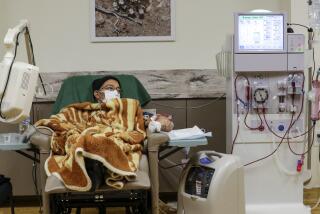Shock-Wave Technique for Kidney Stones Is Debated
- Share via
Four years ago, Joe Noblia had surgery to remove a large and painful kidney stone. He was in the hospital for two weeks, and didn’t fully recover for more than a month.
By last September, Noblia, 67, had developed more kidney stones. But instead of surgery he had extracorporeal shock wave lithotripsy, a relatively new procedure in which stones are bombarded with shock waves that break them up into particles small enough to easily pass through the urinary tract.
“I couldn’t believe how simple it was,” Noblia said. “There was no pain with this at all. I was up and walking the same day, and I drove myself home the next morning.”
Noblia was pleased about the cost, too. The cost of lithotripsy, including hospitalization if necessary, ranges from about $4,000 to $9,000, depending on where the procedure is performed and whether a hospital stay is required. The cost of the conventional surgery starts at $9,000 and can go as high as $18,000.
Experts seem to agree that the machine is a revolutionary step in kidney stone treatment. But some critics see in the advent of lithotripsy a pattern they worry may be similar to what has occurred before in the history of high-technology medicine.
At least twice in the last 15 years--with two different types of exotic body scanner--a seeming technological marvel’s arrival on the scene has been marred by alleged overuse, proliferation faster than proof of usefulness in diagnosis and treatment and races among hospitals to acquire machines primarily for marketing advantage and prestige.
As recently as 1980, if a patient had a stone too large to pass, surgery was the only option. But in the last several years, a number of non-invasive or less-invasive procedures have made open surgery nearly obsolete for the one in 700 Americans hospitalized each year for kidney stone-related problems.
Of all the new procedures, lithotripsy, licensed by the Food and Drug Administration in 1984, is the most popular. Dr. Gerhard Fuchs, of UCLA Medical Center’s Stone Center and one of the first users of lithotripsy, estimates that 70% of all patients needing treatment for kidney stones are candidates for lithotripsy.
Other estimates are even higher. Scientists at Dornier Medical Systems Inc., the German company that manufactures the machine used for lithotripsy, estimate that 90% of all patients requiring treatment can benefit.
The word lithotripsy applies to any process that causes stones in the urinary tract to be crushed. Aside from the new sound-wave variety, there are two other types of lithotripsy in use, but the new process has quickly become the generic term.
Less Than an Hour
The procedure, performed by a specially trained urologist on equipment costing approximately $2 million, takes less than an hour. The patient is anesthetized and positioned in a tub of water. Shock waves generated by a large spark plug are aimed at the kidney stone by a doctor using X-ray equipment. Between 400 and 2,000 waves are then shot through the water, through the body to the stone.
The shock wave can go through most human tissue without causing significant damage, according to the FDA Drug Bulletin, “because the acoustic impedance of most body tissue is similar to that of water.” Lung tissue, however, can be damaged by the procedure and must be carefully avoided.
In most cases, the pulverized kidney stone can pass through the urinary tract without causing the patient much discomfort after the lithotripsy, although sometimes with particularly large or hard stones, follow-up treatment is required. Patients are typically hospitalized for one to four days after treatment.
So far, all studies of lithotripsy’s effectiveness have shown the procedure to be extremely useful in treating kidney stones up to two inches in diameter. A report issued last May by the Congressional Office of Technology Assessment concluded that lithotripsy is “safer, cheaper and more effective for most stones than traditional . . . surgery.”
Proceeding With Caution
Although medical experts are virtually unanimous in their praise for the medical benefits of lithotripsy, many believe there may be medical and policy-related problems associated with the procedure.
In an editorial in the March 27, 1986, issue of the New England Journal of Medicine, Dr. Albert T. Mulley Jr. of Harvard Medical School cautioned doctors to remember that “extracorporeal shock wave lithotripsy is . . . a well-engineered, highly selective application of brute force. It is potentially painful; epidural or general anesthesia is necessary. The shock wave is loud . . . it can cause tissue injury.”
Various studies have cited complications ranging from soreness after the procedure to tissue damage. Several deaths have occurred during or shortly after the procedure, although most have not been conclusively linked to lithotripsy.
Data on the first 2,500 U.S. patients treated reveals four deaths within six weeks of the procedure. Two of the deaths were from unrelated causes; the other two were from stroke and hypertension, respectively, causing researchers to question whether there may exist a relationship between lithotripsy and hypertension.
It is not the medical problems, however, that concern most lithotripsy observers, since all reports to date suggest that lithotripsy is considerably safer than conventional surgery. The most compelling questions, experts say, revolve around just when and how the machine should be used.
Supply-Demand Concerns
Some problems have arisen because of the rapid proliferation of the lithotripter. “The machine is very popular. We have placed 125 of them to date in the United States,” said David Heiden, vice president of sales and marketing for Dornier Medical Systems Inc., the German company that manufactures the machine. Currently the company has a four- to six-month backlog.
But according to the congressional OTA report, fewer than 100 machines would be sufficient to serve the entire U.S. population. “Additional machines may make lithotripsy accessible to more patients, but each treatment will be more costly for the lithotripsy center to provide,” the report concluded.
Heiden said at least 14 lithotripters have been placed in Southern California hospitals, a number many say is excessive. “Three or four lithotripters could easily serve all of Southern California,” said Dr. Peter Fugelso, a urologist who heads the kidney stone center at St. Joseph Medical Center in Burbank.
The Scanners Parallel
Dr. Sidney Wolfe, director of the Ralph Nader-affiliated Health Research Group in Washington, contended that there are potentially disturbing parallels between the rush to acquire lithotripters and the earlier proliferation of the two types of scanners in general use.
The first, an X-ray-based device called the CAT (computerized axial tomography) scanner, was introduced in about 1975. Each CAT scanner cost $750,000 and the machine--followed a few years later by the non-X-ray magnetic resonance imaging scanner--quickly became the target of critics of health-care inflation who contended that the scanners were useful but unnecessary in such large numbers and would inevitably drive up costs.
The same thing may already be said of the lithotripter, Wolfe added. “How many times do you have to go through this high-tech exercise before realizing that you really can’t afford an unlimited amount of waste?” he asked. “The lithotripter certainly is effective. The question is whether it’s being used only where it is the most effective and least expensive option.”
The machines, however, are beginning to be viewed by hospitals as an economic necessity. Huntington Memorial Hospital installed its lithotripter last April, after waiting for it for more than eight months. Despite the high number of such machines in the area, the hospital is happy with its investment.
“It was basically a marketing decision,” said John Faubion, associate administrator for the hospital. “With so many insurance companies contracting with us, it’s a real advantage to be able to say we have a lithotripter. Insurance companies are looking for full-service hospitals, and having a lithotripter means you can provide fuller services.”
Heiden believes there’s another reason that so many hospitals want his company’s product. “It is a very competitive environment today in health care,” he said. “The hospital down the street may already have a lithotripter but you may not want to send them down there. There’s always the threat that if the patient goes to another hospital for (lithotripsy), he’ll keep going there for everything.”
Training Debated
Another issue is the question of training. Under guidelines established by the American Urological Assn., urologists wishing to perform lithotripsy must be trained at one of a handful of teaching centers in the U.S. (In Los Angeles, UCLA is the only such center.) The urologist must participate in at least 15 lithotripsy treatments before receiving certification.
Fuchs and others think that’s not enough. “I think the training requirements are insufficient,” Fuchs said, pointing out that the machinery is complicated and that different stone problems require different treatments.
“It’s like playing a violin,” said Fugelso, who has performed more than 500 of the procedures at St. Joseph Medical Center. “You can make noise with it immediately, but it takes time to learn the intricacies.”
Fugelso performs all the lithotripsy treatments at St. Joseph’s, and he believes the machines should not be used generally by all trained urologists. “If you only perform a few procedures a year, you don’t develop the fine skills required. I was still making major changes in my technique after doing 200 patients,” he said.
Huntington’s Policy
At Huntington, any specially trained urologist can apply to use the lithotripter, and Faubion defends the hospital’s decision to open its machine to outside doctors. “Many hospitals in the area have closed shops where only one or two doctors can perform lithotripsy. Our belief was that since every hospital doesn’t have a machine, we should open ours up to qualified urologists,” he said.
Faubion doesn’t believe opening up the machine to many urologists will decrease the quality of care. “You have to look at the procedure,” he said. “The technical skill required to perform lithotripsy is nothing compared to something like open-heart surgery.”
Another concern is that, as with other procedures, lithotripsy will be overused. “Trained doctors are going to be looking for an excuse to use the machine,” said one urologist who asked to remain anonymous. “Maybe they’ll see a stone on an X-ray, and they’ll figure ‘why not remove it?’ even if the stone isn’t causing any trouble.”
Most urologists agree that kidney stones should be treated when they cause problems. Stones under one centimeter in diameter are often discharged without intervention, and some larger stones don’t seem to cause trouble. “When a stone is causing infection or excessive pain and it can be eliminated with lithotripsy; that’s when we go in,” Fugelso said.
In his office recently, Fugelso turned away an 80-year-old woman whom he didn’t consider a good candidate for lithotripsy. “I could have broken up her stone with the machine,” he said. “But it was in an area of the kidney where the fragments would never get into the urine collection system. She’d have a bunch of fragments in her kidney instead of a larger stone.”





